
The Afsharid dynasty was an Iranian dynasty founded by Nader Shah of the Qirqlu clan of the Turkoman Afshar tribe.

Wilferd Ferdinand Madelung FBA was a German author and scholar of Islamic history widely recognised for his contributions to the fields of Islamic and Iranian studies. He was appreciated in Iran for his "knowledgeable and fair" treatment of the Shia perspective. In the obituary of the Institute of Ismaili Studies (London) where Madelung worked his last years, it reads: "With particular reference to religious schools and movements in early Islam, his studies, based on a vast array of primary sources, have enriched the discipline’s understanding of almost every major Muslim movement and community – not only early Imami Shi‘ism and the later developments of Twelver, Ismaili and Zaydi Islam but also the lesser known aspects of Sunni, Khariji and the Mu‘tazili schools of theology and philosophy."

Baba Tahir or Baba Taher Oryan Hamadani was an 11th-century dervish poet from Hamadan, Iran who lived during the reign of Tugril of the Seljuk dynasty over Iran. This is almost all that is known of him as he lived a mysterious lifestyle. Although prefix "Baba" has been thought as part of his name in all known sources, his nickname "Oryan" did not appear until about 17th-century. The nickname was probably attributed to him because he seemed to lead a very spiritual and stoic lifestyle and thus was figuratively not clothed with worldly and material needs. His poetry is written in the Hamadani dialect of the Persian language. According to L. P. Elwell-Sutton he probably wrote in the Hamadani dialect, adding: "Most traditional sources call it loosely Luri, while the name commonly applied from an early date to verses of this kind, Fahlaviyat, presumably implies that they were thought to be in a language related to the Middle Persian language. Rouben Abrahamian however found a close affinity with the dialect spoken at the present time by the Jews of Hamadan." According to The Cambridge History of Iran, Baba Tahir spoke a certain Persian dialect.
ʾAḥmad ibn Yaḥyā ibn Jābir al-Balādhurī was a 9th-century Muslim historian. One of the eminent Middle Eastern historians of his age, he spent most of his life in Baghdad and enjoyed great influence at the court of the caliph al-Mutawakkil. He travelled in Syria and Iraq, compiling information for his major works.
Batiniyya refers to groups that distinguish between an outer, exoteric (zāhir) and an inner, esoteric (bāṭin) meaning in Islamic scriptures. The term has been used in particular for an allegoristic type of scriptural interpretation developed among some Shia groups, stressing the bāṭin meaning of texts. It has been retained by all branches of Isma'ilism and various Druze groups as well. The Alawites practice a similar system of interpretation. Batiniyya is a common epithet used to designate Isma'ili Islam, which has been accepted by Ismai'lis themselves.
Abu'l-Husayn al-Basri was a Mu'tazilite jurist and theologian. He wrote al-Mu'tamad fi Usul al-Fiqh, a major source of influence in informing the foundations of Islamic jurisprudence until Fakhr al-Din al-Razi's al-Mahsul fi 'Ilm al-Usul.
Dinavar was a major town between the 7th and 10th centuries, located to the northeast of Kermanshah in western Iran. The ruins of the town is now located near Shir Khan, in Dinavar District, Sahneh County, Kermanshah Province.

The Encyclopaedia Islamica is an encyclopedia on Islamic and Iranian studies published by Brill, comprising a projected 16-volume translation of selected articles from the new Persian Dā'erat-ol-Ma'āref-e Bozorg-e Eslāmi, supplemented by additional articles written in English by scholars affiliated with the Institute of Ismaili Studies.
The İslâm Ansiklopedisi (İA) is a Turkish academic encyclopedia for Islamic studies published by Türkiye Diyanet Vakfı.
Farhad Daftary is a Belgian-born Iranian-British Islamic scholar who is co-director and head of the Department of Academic Research and Publications at the Institute of Ismaili Studies in London. He is related to the Aga Khan IV.

Bibi Shahrbanu Shrine is a shrine located near Shahr-e Ray, a southern suburb of Tehran, Iran.
The dehqân or dehgân, were a class of land-owning magnates during the Sasanian and early Islamic period, found throughout Iranian-speaking lands. The deqhans started to gradually fade away under the Seljuks and Qarakhanids, due to the increase of the iqta' and the decline of the landowning class. By the time of their dissolution, they had played a key role in preserving the Iranian national identity. Their Islamization and cultural Iranianization of the Turks led to the establishment of the Iranian essence within the Islamic world, something which would continue throughout the Middle Ages and far into modern times.

The Kar-Kiya dynasty, also known as the Kiya'ids, was a local dynasty which mainly ruled over Biya-pish from the 1370s to 1592. They claimed Sasanian ancestry as well. Lahijan was the dynasty's capital.

Ali Reza Abbasi Tabrizi was a prominent Persian calligrapher and calligraphy teacher, who flourished in 16th-17th century Safavid Iran. He was titled by Abbas I as Šāhnavāz Xān. Abbasi was a master of Naskh and Thuluth scripts and the initiator of his own style of Nastaʿlīq script. Besides he was an expert of various other scripts like Muhaqqaq, Reqa, Reyhan, Tevki and Taʿlīq scripts.
Hamdan Qarmat ibn al-Ash'ath was the eponymous founder of the Qarmatian sect of Isma'ilism. Originally the chief Isma'ili missionary in lower Iraq, in 899 he quarreled with the movement's leadership at Salamiya after it was taken over by Sa'id ibn al-Husayn, and with his followers broke off from them. Hamdan then disappeared, but his followers continued in existence in the Syrian Desert and al-Bahrayn for several decades.

The Jameh Mosque of Dezful first and oldest mosque built in Dezful, located in the Dezful County, is located on Imam Khomeini Street. The construction of this mosque is a Sasanian architecture style.

Jahangir was the uncontested leader of the Aq Qoyunlu from 1444 to 1454, but afterwards fell into a dynastic struggle with his younger brother Uzun Hasan, who by 1457 had defeated him and assumed full power over the confederation. Jahangir later died in 1469.
Rustam Beg Bayandur was a Aq Qoyunlu prince, and one of the contesters in 1492–1497 during the dynastic struggle that had erupted following the death of Ya'qub Beg. He was deposed by his cousin Ahmad Beg.
Abol-Hasan Golestaneh was an Iranian government official from Isfahan, who wrote the historical chronicle of Mojamal al-Tawarikh in 1780. It was an important source for the events that followed after the death of the Iranian ruler Nader Shah, including the establishment of the Durrani Empire by the Afghan ruler Ahmad Shah Durrani, as well as the political affairs in western Iran between 1747 and 1782.
The Hasanvand are a Lur Laki-speaking tribe mainly settled in the Lorestan province of Iran. According to a 2008 census from the Statistical Center of Iran, the Hasanvand had 1,121 households in their summer pasture in Lorestan.









